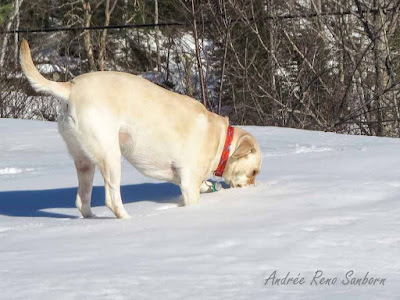%2014.jpg) |
| Lucy enjoying a mouse in a past summer. |
We had the day yesterday.
In January and February the shrews invade the cellar through the granite boulders of the foundation. The cats are always ready for them. Sometimes, they have gotten six in one day. But then the weather warms just slightly and the shrews (the survivors) leave. I have never read an explanation of why we are invaded in those months. I have even written to a vertebrate biologist but he also had no idea. Except for the weather, of course. The weather in January and February here in northern Vermont is brutal. It makes you wonder why any of us, human or not, live here at all. Our biggest storms, darkest days and coldest temperatures are during those months.
 |
| Nelly with a Northern short-tailed shrew. |
Shrews, to me, look like chubby basset-hound type mice; they are low-slung and chubby. They have a toxic bite and taste vile. Cats will kill them but will never eat them. I have to keep a close eye on cat activity to make sure that I don't have a dead shrew body fouling the air after a few days here.
 |
| A Northern short-tailed shrew in Québec. Alive. Photo by Gilles Gonthier |
Yesterday, Nelly was stalking a shrew on my main floor. She had captured it and brought it up from the cellar. The problem was, that as it scuttled across the floor in front of me, I was startled and gasped. My gasps put Lucy on alert, and she immediately went for the shrew.
But John and I had spent much time gently teaching Lucy to never steal a cat's prey, so she just watched the shrew. Then came my next mistake: Nelly seemed to have lost track of the shrew, so I called out to tell her where it went before it disappeared. Nelly moved towards the shrew, but Lucy took my shrew-alert as permission to get the shrew. She grabbed it and took it to bed. It was squeaking the entire way. (Shrews die loud.)
I was very fortunate that yesterday was a day that Amy was coming to visit and help. She went upstairs, found the shrew easily on my bed, removed it and brought the top bloodied quilt—the ancient, raggedy quilt that covers the entire top of the bed for just this reason—down to the laundry. Lucy did not go upstairs with Amy. She knew that she had overstepped.
Lucy continues to hunt mice under the snow. It is her favorite winter activity. Dogs hunt mice much as foxes do: they follow a scent and/or a sound, and pounce. She is often successful and swallows them whole. And alive. I can't think too closely about swallowing live mice before my insides churn. It is probably best if you not think about it, either.
 |
| Lucy mouse hunting last winter. |
I hope I don't have to re-teach Lucy to leave cat prey alone. It is a difficult thing to overcome a dog's natural instinct to hunt and you have to be careful, gentle, and understanding. But in the past, when she took the cats' kills, they became secretive and rodent body parts were rotting throughout the house. I don't want that to happen again. I also have to be more mindful of my reactions to their behaviors because my behaviors grant them permission for their own behaviors. No gasping at their prey, I can only show that I am pleased. No confusing conversations with a cat when a dog is in the same space; unless I use other ways to show Lucy that I am only talking to the cat (which has been very successful in the past). Yesterday, I lost all of my own training!
To learn more about Northern short-tailed shrews, see A Voracious and Venomous Mammal.
🌼 🌼
Meteorological spring begins on March 1. Northern Vermont spring is late May. I could not, will not, wait, so I put up my spring blog banner of Canada geese goslings. After all, tomorrow is March 1.


















